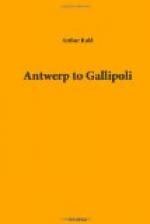Cracow is Polish in atmosphere and feeling, and even in the few hours we were there one heard a good deal of Polish hopes and ambitions. The independence which Russia was to grant must come now, it would appear, from some one else. The Poles want a king of their own, but apparently they preferred to be under the wing of Austria rather than of Germany. The Germans, who had laid rather a firm hand on the parts of Poland they had occupied, might not fall in with this notion and one could detect here one of those clouds, “no bigger than a man’s hand,” which dramatists put in the first act, and which often swell to interesting proportions before the final curtain goes down.
Chapter XVI
In The Dust Of The Russian Retreat
Warsaw had fallen, and Ivangorod, and the centre of the German and Austro-Hungarian armies, sweeping across eastern Europe like beaters across a prairie, was now before Brest-Litovsk. This was the apex of this central triangle of Russian forts, a city and a rail-road centre as well as a fortress, and the last strongly fortified place on the direct road to Moscow. It seemed as if the Russians must make a stand here, and even though we were four or five days getting there, the heavy artillery was not yet up, and there might still be time.
We wound through the green hills and under the ruined castles of northern Hungary in the afternoon, rolled slowly up across Silesia and into Russian Poland in the night, and came at noon to Radom, only sixty-five miles south of Warsaw. Hindenburg had been here in October, 1914, when he invaded Poland to draw off the Russians from Galicia, then the Russian offensive had rolled over the place. The Russians had held it all the winter; now they were a hundred and fifty miles eastward— beyond the Vistula and the Bug—“boog,” not “bug,” by the way—and just hanging to the edge of Poland.
The war had scarcely touched Budapest and Vienna—scarcely touched the ordinary city surfaces, that is to say. In hotels and cafes, streets and parks, life flowed on almost as brightly as ever. Farther north, in the Hungarian towns and villages, life still went on as usual, but one felt the grip of war—you might not go there nor move about without a military pass. Beyond Radom, where now in the pleasant park the very literary Polish young people were strolling, reading as they walked, there was, so to speak, no ordinary life at all—only the desert of war and the curious, intense, and complicated life of those who made it. Our car was hitched to a long transport-train—for it would be another two days before the automobiles would come back for us from the front— and we rode into this deserted Polish country toward Ivangorod.




